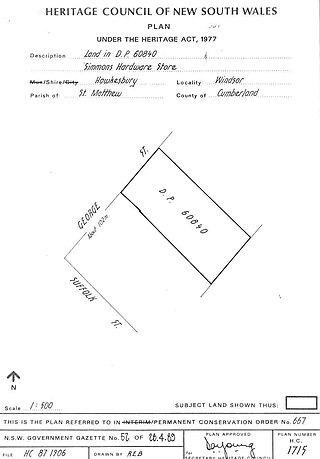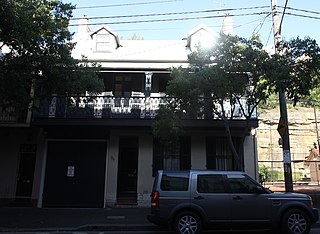
Muswellbrook railway station is a heritage-listed railway station located on the Main Northern line in Muswellbrook, in the Muswellbrook Shire local government area of New South Wales, Australia. The station serves the town of Muswellbrook and was designed by John Whitton, the Chief Engineer of NSW Railways. It is also known as Muswellbrook Railway Station and yard group and Musclebrook Railway Station. The property was added to the New South Wales State Heritage Register on 2 April 1999.

Muswellbrook Shire is a local government area in the Upper Hunter region of New South Wales, Australia. The Shire is situated adjacent to the New England Highway and the Hunter railway line.

Loder House is a heritage-listed residence at 126 George Street, Windsor, City of Hawkesbury, New South Wales, Australia. It was built in 1834. It has been used at times for various other purposes: as a bank, multiple restaurants, a guesthouse and a bookshop. It was added to the New South Wales State Heritage Register on 2 April 1999.

The Howick Street houses are five heritage-listed neighbouring semi-detached houses at 194, 196, 198, 200 and 202 Howick Street, Bathurst, Bathurst Region, New South Wales, Australia. 194, 196 and 198 are separately heritage-listed, while 200 and 202 are listed together. The houses are privately-owned. It is also known as Terrace Cottages. The five houses were all added to the New South Wales State Heritage Register on 2 April 1999.

Royal Hotel is a heritage-listed Australian pub at 59–61 Lambie Street, Cooma, Snowy Monaro Regional Council, New South Wales, Australia. It was built from 1858. It was added to the New South Wales State Heritage Register on 2 April 1999.

Loxton House is a heritage-listed former residence and now restaurant located at 142–144 Bridge Street, Muswellbrook in the Muswellbrook Shire local government area of New South Wales, Australia. It was built in 1838 and was added to the New South Wales State Heritage Register on 2 April 1999.
Muswellbrook Post Office is a heritage-listed post office at 7 Bridge Street, Muswellbrook, New South Wales, Australia. It was added to the Australian Commonwealth Heritage List on 08 November 2011.

Davisville is a heritage-listed former YWCA women's home, residence and commune and now residence and bed and breakfast at 63-67 Falls Road, Wentworth Falls, City of Blue Mountains, New South Wales, Australia. It was built from 1888 to 1920 by David Davis, Sydney builder. It is also known as Rennie House. It was added to the New South Wales State Heritage Register on 2 April 1999.

Balmain Hospital Main Building is a hospital building and former cottage in Balmain, New South Wales, a suburb of Sydney, Australia. It was the original building of and remains the administration building for the Balmain Hospital. It was designed by E. J. Bowen and built in 1880. It is also known as the Administration Building, and includes the Evans Ward and the Victoria Ward. The property is owned by the NSW Department of Health. It was added to the New South Wales State Heritage Register on 2 April 1999.

The 203–205 Albion Street, Surry Hills Cottages are two heritage-listed cottages located at 203–205 Albion Street in the inner city Sydney suburb of Surry Hills in the City of Sydney local government area of New South Wales, Australia. It was built in 1840 by George Hill. The property is owned by the Royal College of Pathologists of Australasia. It was added to the New South Wales State Heritage Register on 2 April 1999.

Simmons Hardware Store is a heritage-listed commercial building located at 226 George Street, Windsor, City of Hawkesbury, New South Wales, Australia. It is also known as Peter O'Hara's General Store and Simmons Store. It was added to the New South Wales State Heritage Register on 2 April 1999.

Lilyvale is a heritage-listed former town house and now restaurant located at 176 Cumberland Street, in the inner city Sydney suburb of The Rocks in the City of Sydney local government area of New South Wales, Australia. It was built from 1845 to 1847. The property is owned by Property NSW, an agency of the Government of New South Wales. It was added to the New South Wales State Heritage Register on 10 May 2002.

Samson's Cottage wall remains is a heritage-listed former residence and now retail building located at 8 Kendall Lane, in the inner city Sydney suburb of The Rocks in the City of Sydney local government area of New South Wales, Australia. It was built for William Samson in 1844. It is also known as Samson's Cottage (wall remains) and Puppet Cottage (Samsons). The property is owned by Property NSW, an agency of the Government of New South Wales. It was added to the New South Wales State Heritage Register on 10 May 2002.

55–59 Harrington Street, The Rocks are heritage-listed serviced apartments and a former terrace house located at 55–59 Harrington Street, in the inner city Sydney suburb of The Rocks in the City of Sydney local government area of New South Wales, Australia. It was built from 1886. It is also known as Stafford Terrace; Stafford Apartments and 75 Harrington Street; Clocktower Development. The property is owned by Property NSW, an agency of the Government of New South Wales. It was added to the New South Wales State Heritage Register on 10 May 2002.

Toxteth is a heritage-listed residence located at 94 Kent Street, in the inner city Sydney suburb of Millers Point, New South Wales, Australia. It was added to the New South Wales State Heritage Register on 2 April 1999.

14-16 Merriman Street, Millers Point is a heritage-listed stone cottage located at 14-16 Merriman Street, in the inner city Sydney suburb of Millers Point in the City of Sydney local government area of New South Wales, Australia. It was built from 1837 to c. 1840. It is also known as Stone Cottage & Wall. The property was added to the New South Wales State Heritage Register on 2 April 1999.

Undercliffe Terrace is a heritage-listed row of terrace houses located at 52–60 Argyle Place, in the inner city Sydney suburb of Millers Point in the City of Sydney local government area of New South Wales, Australia. The property is also known as Grimes' Buildings. was added to the New South Wales State Heritage Register on 2 April 1999.

Undercliffe Cottage is a heritage-listed residence located at 50 Argyle Place, in the inner city Sydney suburb of Millers Point in the City of Sydney local government area of New South Wales, Australia. It is also known as Undercliff Cottage; and Grimes Cottage. The property was added to the New South Wales State Heritage Register on 2 April 1999.

46–48 Argyle Place, Millers Point is a heritage-listed terrace house and now boarding house located at 46–48 Argyle Place, in the inner city Sydney suburb of Millers Point in the City of Sydney local government area of New South Wales, Australia. It was built during 1850. The property was added to the New South Wales State Heritage Register on 2 April 1999.

Linsley Terrace is a series of heritage-listed terrace houses located at 25–35 Lower Fort Street, in the inner city Sydney suburb of Millers Point in the City of Sydney local government area of New South Wales, Australia. It was built from 1830. It is also known as Major House. The property was added to the New South Wales State Heritage Register on 2 April 1999.





















